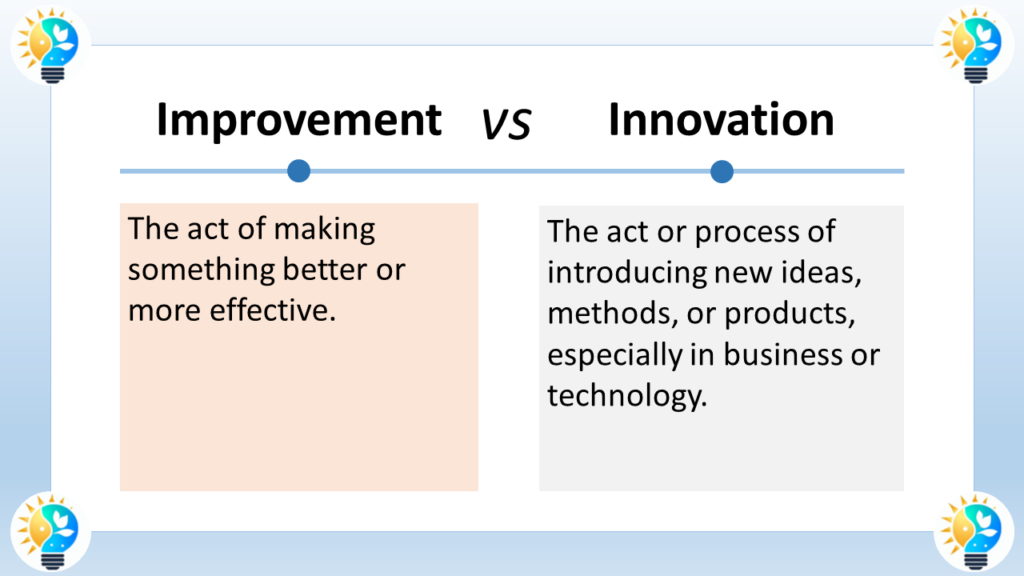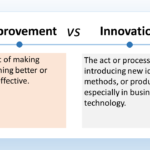The difference between improvement and innovation mainly revolves around the scope and nature of change they introduce to processes, products, or services within any given field.

Definition
Improvement
Improvement is the process of making something better by enhancing its existing qualities or performance.
- Characteristics of Improvement:
- Incremental: Enhancements are often gradual and continuous.
- Refinement: Focuses on optimizing current methodologies or technologies.
- Efficiency: Aimed primarily at increasing productivity or quality without fundamental changes.
Innovation
Innovation involves creating and implementing novel ideas or approaches that result in significant changes or completely new offerings.
- Characteristics of Innovation:
- Radical: Can be a major leap forward, breaking away from traditional methods.
- Originality: Introduces concepts or products that are unprecedented.
- Disruption: Has the potential to alter the way entire systems or industries operate.
More Synonyms on innovation, innovate and innovative
Innovation Terms

Innovation is considered as a driving force in progress.
It includes the introduction of novel ideas, methods, or products that bring positive change and advancement.
For more information about innovations, check our glossary
Relationship and Relevance
Improvement is about taking what already exists and making it better, while innovation is about introducing something new to the equation. Improvements are often necessary to maintain competitiveness, but innovations can shift market dynamics and create new opportunities.
The key differences between improvement and innovation are:
Improvement
- Refers to making incremental changes and enhancements to existing products, processes or systems to make them better, more efficient or higher quality.
- Focuses on optimizing and refining what already exists. It is an iterative, evidence-based approach.
- Aims to achieve better results through small, gradual changes. It relies on benchmarking and identifying areas for optimization.
- Has a lower failure rate as it builds on existing knowledge and resources.
Innovation
- Refers to creating something entirely new - a novel product, service, process or business model that did not exist before.
- Involves a more radical, ground-breaking approach that challenges the status quo. It is about exploring uncharted territories.
- Driven by a desire to do things differently rather than just better. It is proactive and visionary.
- Has a higher failure rate as it involves uncertainty and risk-taking, but can also have greater potential impact.
In summary, improvement is about making incremental enhancements to existing solutions, while innovation is about creating fundamentally new solutions. Both are important and complementary capabilities for organizations to thrive. The most effective leaders are able to balance and leverage both approaches as needed.
Context for Using Each Term
- Improvement should be used when describing enhancements made to an existing entity, such as a product's features or a system's performance.
- Innovation should be used when discussing the introduction of something completely new that changes existing patterns, processes, or frameworks.
Example of Utilization
If a car manufacturer increases the fuel efficiency of an existing engine model, it is an improvement. However, if the same manufacturer develops a new electric engine that changes the way cars are powered, it is an innovation.
In conclusion, improvement and innovation are both crucial for growth and development, but they serve different purposes. Improvement focuses on enhancing what's already there, whereas innovation is about creating new pathways and possibilities that did not exist before.
FAQ
Q: Can improvements lead to innovation?
A: Yes, a series of improvements over time can accumulate to create significant changes that may be considered innovations.
Q: Is innovation always better than improvement?
A: Not necessarily. The choice between improvement and innovation depends on specific needs, resources, and goals. Sometimes, steady improvements are more appropriate and effective.
Q: How do improvement and innovation contribute to progress?
A: Improvement ensures continuous enhancement of existing systems, while innovation introduces new solutions that can lead to significant leaps in progress.
Q: Can innovation and improvement coexist in a single project?
A: Absolutely. Many successful projects combine innovative elements with improvements to existing components or processes.

